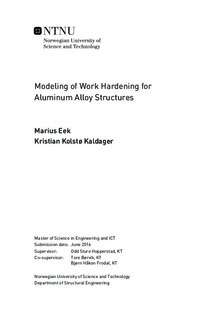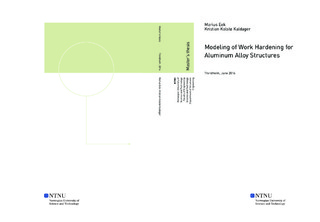| dc.contributor.advisor | Hopperstad, Odd Sture | |
| dc.contributor.advisor | Børvik, Tore | |
| dc.contributor.advisor | Frodal, Bjørn Håkon | |
| dc.contributor.author | Kaldager, Kristian Kolstø | |
| dc.contributor.author | Eek, Marius | |
| dc.date.accessioned | 2019-09-11T08:34:52Z | |
| dc.date.available | 2019-09-11T08:34:52Z | |
| dc.date.created | 2016-06-10 | |
| dc.date.issued | 2016 | |
| dc.identifier | ntnudaim:15518 | |
| dc.identifier.uri | http://hdl.handle.net/11250/2614901 | |
| dc.description.abstract | The hardening behavior of aluminum alloys can be described by a combined material model with both isotropic and kinematic hardening. The kinematic contribution is often excluded in numerical simulations if a cyclic stress state is not suspected, because additional experimental tests and calibration is required to include this contribution in the combined hardening model. This thesis examines the influence of a combined hardening model for an aluminum alloy AA6060 in tempers T4, T6 and T7 with respect to the structural response, compared to the increased complexity.
Pure tension, tension-compression and compression-tension load reversal tensile tests were performed in a uniaxial stress state. The experimental results obtained in this thesis showed a significant dispersion of the yield stress within each temper. The load sequence of the tensile tests was concluded to be insignificant for the experimental results. Distinct differences in the work hardening between the three tempers were experimentally observed. From the experimental data two material hardening models were calibrated: purely isotropic and combined isotropic-kinematic. These models were used for numerical finite element simulations of several cases in Abaqus including axial crushing, forming limit diagram, impact loading on stiffened plates and blast loading on clamped plates.
Temper T4 showed greater strain distribution and a reduced chance of fracture, compared to T6 and T7. The results found in this thesis suggest only minor differences between the two material hardening models. For the cases in this thesis it was concluded that using a combined material hardening model is not necessary for aluminum alloy AA6060 in tempers T4, T6 and T7, considering the increased cost and time required for additional calibration, when performing numerical simulations not subjected to considerable fluctuating stress states. | en |
| dc.language | eng | |
| dc.publisher | NTNU | |
| dc.subject | Ingeniørvitenskap og IKT, Konstruksjonsteknikk | en |
| dc.title | Modeling of Work Hardening for Aluminum Alloy Structures | en |
| dc.type | Master thesis | en |
| dc.source.pagenumber | 153 | |
| dc.contributor.department | Norges teknisk-naturvitenskapelige universitet, Fakultet for ingeniørvitenskap,Institutt for konstruksjonsteknikk | nb_NO |

